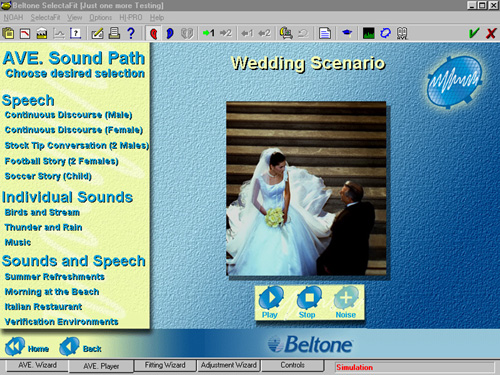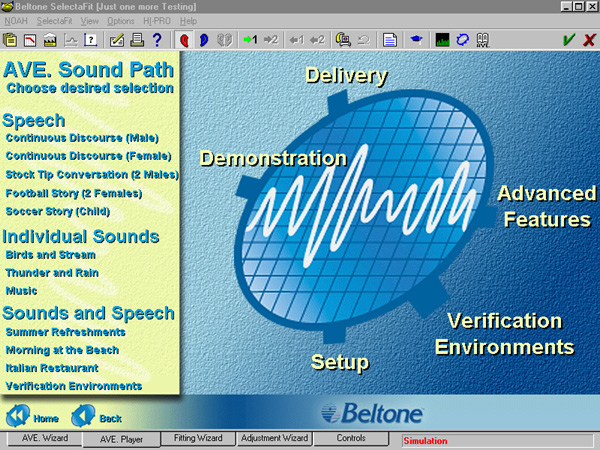Providing appropriate amplification for patients is often more art than science. Even though the tools we use when fitting amplification, such as test protocols, speech materials, and even the hearing instruments themselves are rigorously developed and tested, in the final analysis we, as audiologists, ask the patient 'How does it sound?' often times with our fingers crossed and holding our breath.
Until now, we relied on what we can measure regarding the electroacoustic performance of the hearing instruments. We have electroacoustic measurements which tell us that the instruments are providing the appropriate power, gain, and frequency response, based on ANSI specifications. We can perform real-ear measurements, which tell us how the hearing instruments are acoustically and electronically performing (meeting target) within a given ear canal.12 We can provide aided versus unaided sound field measures to directly measure the benefit of amplification on given stimuli. We can use questionnaires and other written assessment tools to help verify needs and establish accomplished and lingering goals.3
But how do we know we are providing appropriate amplification for that individual patient across the highly individualized acoustic situations in which the patients find themselves, as soon as they leave the artificial environments we test and verify in?
Of course we trust the patient to report honestly about his or her perception of the amplified signal, but can we expect an honest or reliable judgment about real-life experiences, when the patient is sitting in our consulting room or sound suite?
MarkeTrak V statistics tell us that 73% of patients are satisfied with their hearing instruments after three months, but the number dwindles to 60% satisfaction after one year. There is a consistent pattern of higher satisfaction ratings as the number of 'listening situations satisfied' increases.4 Clearly, patients are telling us they judge their hearing instruments' performance, and their satisfaction, not on the number of electronic specifications that are met, but on how they perceive amplified sound in a variety of listening situations.
So the question for audiologists becomes: How can we be certain that the amplification we provide, despite all its electronic precision, is giving the patient what he or she needs in specific listening situations?
What is needed is an easy-to-use surround sound system that replicates real life sound scenarios so patients can make judgments based on what they are likely to hear when they leave the office and go about their daily lives.
The Beltone AVE.TM (Audio Verification Environment, pronounced 'avenue') is such a system.5 The Beltone AVE.TM is a plug-in to Beltone's fitting software, SelectafitTM, providing a seamless integration of hearing instrument adjustments in response to patient perceptions. The system employs four measured speakers and subwoofer in a controlled acoustic environment. (Recommendations for modifying the acoustic space are provided with the AVE. system.) Beltone Electronics Corp. consulted with acousticians in developing guidelines for providing the optimum acoustic environment for using the AVE. system, essentially creating a 'sweet spot' in which the patient listens. In addition, real-world sound recordings were made with a multi-array sound field microphone to assure the most realistic sound quality possible.
For example, the pharmacy sound track in the AVE. 'Verification Environments' section was recorded in an actual pharmacy, and is neither artificially enhanced to accentuate the multiple voices, nor artificially muted to soften the often annoying sounds of the cash register, or the jingling of coins. All sounds are present as recorded on that day. 
The wedding scenario was recorded in a church, and is similarly free from sound-studio mixing. The idea behind the Beltone AVE. is not to make it sound better, but to make it sound accurate and real.
In addition to the pharmacy and wedding scenarios, there is a baseball game, a setting of two people in a kitchen, a business office, a coffee shop setting, and a man and woman out driving. In addition to these environmental scenarios, the AVE. has a sound library of over 120 individual sounds, which can be selected by category, alphabetically, or by typing in the name of the sound (e.g., bowling alley).
The Beltone AVE. can be used in all phases of the hearing instrument fitting process, from demonstration to delivery to fine-tuning, providing sophisticated tools to assist the practitioner in addressing patient concerns. The patient is seated before a computer screen, at optimum distance from four speakers: two mounted in front of the patient, and two behind the patient at ear level. Levels are set with a sound level meter to assure accurate playback volume. Beltone has developed three clinically tested protocols: demonstration, delivery, and follow-up (or fine-tuning). 
In the demonstration protocol, BTEs with Digital Signal Processing and directional microphones (dual mics) are used to demonstrate the effects of amplification. First, the patient listens to a passage of continuous discourse with a full range of soft, average, and loud voices. The clinician has a choice of a male, female, or child talker. The patient is asked questions relating to the content and quality of the sound passage. Then, the patient's audiogram is entered into the fitting software, and the hearing instruments are programmed to provide optimum gain for soft, normal, and loud sounds. The hearing instruments are placed on the patient, and the same passage is played, demonstrating the benefit of amplification. For previous wearers of amplification, this demonstration can be used to compare their older amplification system to digital (or other) instruments.
Directional microphone benefits and noise reduction circuits can also be demonstrated, using not only the continuous discourse, but also a variety of scenes where conversation is recorded in the presence of background noise.
Importantly, the effect of hearing loss can also be somewhat demonstrated to a spouse or significant other. The Beltone AVE. employs a Hearing Loss Simulator. The simulator uses a choice of sound scenarios filtered to approximate the audibility of the selection, dependent upon the given hearing loss. The scenarios are frequency weighted to demonstrate a high frequency, low frequency, or broadband hearing loss. Our experience has shown this to be a very powerful and sometimes emotional demonstration for the significant other, who may not have fully appreciated the impact of the hearing loss. Of course the simulator does not introduce inner ear or neural distortion, but often the demonstration of the spectral aspects of the hearing loss is quite informative and useful.
At the time of instrument delivery, the Beltone AVE. allows the clinician to make adjustments to prescriptive targets based on the patient's perception of actual sound environments. During the delivery protocol the patient listens to a variety of sound files of different frequency ranges and loudness levels. Since Beltone's fitting software generates targets for soft, average, and loud sounds, the clinician has a choice of sound files that play everyday sounds of differing intensities and that have either high frequency, low frequency, or broad-band frequency ranges. In the loud, broad band category the patient can listen to a car alarm, a chain saw, a jackhammer, or an airplane taking off; in the soft, high frequency category, the patient can listen to crickets, a kitten mewing, wind chimes, or dry cereal being poured into a bowl, and milk added. There are a total of 36 sounds to choose from in the Sound Matrix. The key is to choose the sounds most relevant to the patient, based on the patient's lifestyle and listening challenges.
Regardless of the precision a prescriptive formula may offer, the most rigorously proven formulas are of necessity based on 'average' data and cannot fully meet all the listening needs of a particular individual. With a system like the AVE. adjustments to the hearing instruments' response can be made based on the patient's subjective comments. This increases the likelihood that the patient will not only have a set of hearing instruments specifically adjusted to his or her individual needs and preferences, but it is a very effective way of setting realistic expectations, which can be crucial in the success of the fitting.
Using the AVE., the patient has the ability to understand that the sound of the lawnmower might be objectionably loud -- but that's how it really sounds and we can adjust for the patient's UCL accordingly. The patient begins to understand that rain on the roof is supposed to sound like a hundred fingernails drumming on a desk. Using realistic sound presentations and adjusting the hearing instruments to maximally 'handle' the sounds as the patient desires, allows the patient to understand that even an instrument that is otherwise 'perfect', is not going to handle all sounds as the patient may prefer.
Specifically, some sounds in life are annoying, distressing, uncomfortable and unpleasant - despite amazing technology! The AVE. can serve as a counseling tool and a resource to better understand and explain the daily acoustic environment and the abilities and advantages of different hearing instruments and assistive listening devices (ALDs).
To help the patient understand what to expect from amplification in a variety of listening environments, the Beltone AVE. provides seven verification environments so the patient can experience the sound quality and audibility of those environments through his or her hearing instruments.
The Beltone AVE. also has a protocol for identifying potential feedback, verifying overall gain, identifying occlusion, and setting binaural balance. A few extra minutes spent with the AVE. at delivery can mean fewer problems in the days and weeks to come, and greater patient satisfaction.
Audiologists using the Beltone AVE. report it is user-friendly and the software is easy to navigate. The audiologist can follow the pre-designed protocols that walk through every step, from demonstration to follow-up fine-tuning. Or, if desired, the audiologist can access every program independently, as necessary. If a patient is coming in for a 6 month check-up, and has some concerns regarding a particular listening situation, or even a particular sound, the audiologist can go directly to the Verification Environments or the Sound Library to put the patient 'in the action', and make any necessary adjustments.
The Beltone AVE. has been available since May, 2000. Data from actual field usage has shown the benefits of this tool in increasing the number of hearing instruments fitted, improving the product mix to favor higher technology instruments, increasing the number of binaural fittings, and reducing the number of returns for credit.
Of the offices that have embraced this new technology, we have seen the following trends:
All of these figures are based on data comparing the same four month period of 2000 v. 1999.
Beltone Electronics Corp. is excited about the benefits to patients and audiologists derived from using the Beltone AVE. For the audiologist, the AVE. provides more precise fittings, which directly address the patient's listening experiences. For patients, the AVE. is a way for them to experience real-world sounds through amplification before they leave the office.
The next time a patient is in your office trying to describe a particular listening problem with his or her hearing instruments, think of how it would be if that sound were available to you with the click of a mouse. As we move to higher technology fittings, we need higher technology fitting tools to demonstrate the value to our patients in the office.
REFERENCES
- Byrne D. & Dillon H. (1986). The national acoustics laboratories' (NAL) new procedure for selecting gain and frequency response of a hearing aid. Ear &Hearing, 7(4), 257-265.
- Mueller, H.G., Hawkins, D.B., Northern, J.L, (1992). Probe Microphone Measurements; Singular Publishing Group; San Diego
- Abrams, H. (2001) 'Outcome Measures: in health care today, you can't afford not to do them,' Hearing Journal, 54(2), 10-16
- Kochkin, S. (1999) 'MarkeTrak V: 'Baby Boomers' spur growth in potential market, but penetration rate declines,' Hearing Journal, 52(1), 33-48
- Meskan, ME & Robinson, JL, (2000) 'A Patient Focused Approach to Fitting Hearing Instruments', Hearing Review, Dec 00, 7(12), 52-55
Click here to visit the Beltone website.
